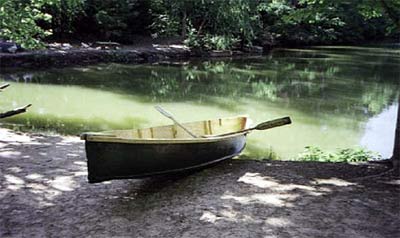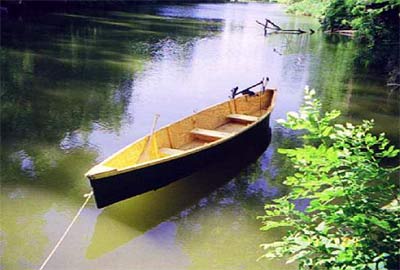| 
Loon is a fast, safe, large pirogue
(or simple canoe) for paddle, oar, or small outboard propulsion.
She is low and narrow, which allows her to be easily driven by
one or two people, but she still has plenty of carrying capacity
for three or more adults plus a trolling motor and battery, or
a load of up to 750 lbs. Loon would make an ideal family boat.
With just four inches of draft
when normally loaded, Loon is perfect for exploring very shallow
marshes, creeks, and rivers. She would be the perfect boat for
hunting, fishing, or just messing about on the water. Loon also
has serious potential as a craft for long camping trips where
it’s necessary (or desirable) to carry a lot of gear.
Unlike many of her kind, this pirogue
is very stable. A 150 lb. person can sit on the gunwale and still
have six to eight inches of freeboard remaining. Her flaring sides
also lend great reserve stability, and the 3’5” beam
is a good compromise between initial stability and ease of paddling.
Weight of the prototype was 165
lbs. - light enough to be easily handled by two average-strength
people - using heavy Yellow Pine plywood, but it should be possible
to cut that by at least 30 lbs. by using lighter woods (such as
fir plywood and fir or cedar framing). Also, the heavy construction
was designed for longevity and strength, and it could be lightened
in several areas without compromising performance.
For a boat this big, she is surprisingly
easy for one person to paddle, but two paddlers are much better.
She certainly is as easy to paddle as many conventional canoes
and is, if anything, more maneuverable because of her bottom rocker.
Also, she will be faster because of her longer waterline.

The easily-driven hull also makes
her a great rowboat - as the oarsman (or woman) increases power,
she responds with little added wake. Many have noted that long,
narrow flat-bottomed boats like this often seem to defy the rules
of hull speed, and Loon is certainly no exception. This makes
her an excellent candidate for an electric trolling motor. Fortunately
for the home builder, she is also very attainable.
It’s perfectly possible
that a relatively inexperienced builder could complete a Loon
in well under 40 hours of part-time work for a total of less than
$200. The latter represents the current tab for a quart of epoxy
(to seal the hull below the waterline), some linseed oil, glue,
screws, paint, 2x4’s and 4 sheets of ¼” exterior
plywood - that’s all there is to her. Of course, if you
used marine plywood and covered the hull with glass cloth and
epoxy the project could potentially take twice as long and cost
3 times as much (or more). Even so, you’d still be far below
the cost range of some of the comparable fiberglass boats.

An experienced builder could slap
one of these hulls together in a weekend, though finishing would
necessarily be spread out over a several-day period to allow time
for paint to dry, epoxy to cure, etc.
However, the plans were drawn with
the complete novice as well as the experienced craftsman in mind.
Both inside and outside chine versions are covered in the plans
and instructions, though the inside chine option is not recommended
for beginners due to its slight added complexity.

The hull shape is extremely simple - the bottom
is the only place where curved cuts need to be made, and even
there it isn’t necessary to expand the panel shape - just
lay the plywood on the hull and take the shape from the assembly.
The straight sides mean that the gunwales and chines fall naturally
into place, without any complicated torturing or steaming.
There are no jigs or temporary forms to deal with
either - the boat is built around her three permanent bulkheads.
The side panels are a constant 16” width for their entire
length, and I worked a little twist into the forward and after
sections to prevent the bottom rocker from becoming too pronounced.
These straight yet slightly torqued panels have the additional
advantage of appearing elegant in three dimensions, without revealing
their simple shape. Loon is a very pretty boat. No lofting is
required, and there are no foreseeable snags for the first-timer
in the building process, yet the boat is equally suited to an
experienced builder looking for a new project.
Loon’s plans are large-scale drawings on two 24”x
36” sheets, and include 30 pages of notes and instructions,
plus several pictures of the prototype. Plans to build one boat
are available for $45USD (shipping included in the USA; please
add $5USD for international orders) from:
Zach Garrett
P.O. Box 326
Broken Arrow, OK 74013
zachg@valornet.com
Or order securely online at:
www.boat-design.com


|

